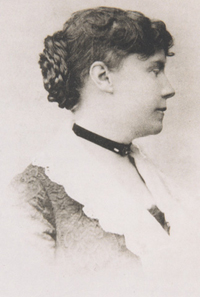Constance Fenimore Woolson
(1840–1894), considered one of the best writers of her
generation for the precise realism and deep empathy with which she depicted Americans of her day and their ways—from the people of the rural Midwest to the socially refined ex-pats in Europe, of whom she eventually became one. The Wall Street Journal has called her “An American realist of a high order [who] paved the way for authors such as Edith Wharton, E. M. Forster and Willa Cather.” Reviewing a new selection of her work, Miss Grief and Other Stories (2016), The New York Times found that Woolson’s short stories “demonstrate irony, force and feeling that occasionally surpass the stories of Edith Wharton and Howells, rivaling ‘the Master’ [Henry James] himself.” In fact, Woolson, a close friend of James, who deeply admired her writing, is now believed to have partly inspired Isabelle Archer, the heroine of The Portrait of a Lady.
But a “lady” in the sense that her times understood the term, Constance Fenimore Woolson, a grand-niece of novelist James Fenimore Cooper, was not destined to be. Born in Claremont, New Hampshire, she was taken as a child to Cleveland, where luck put her into the hands of two women who would play important roles in shaping the person she became. The first was Harriet Grannis, her teacher at Miss Fuller’s School on Public Square. Educated at Oberlin College and a published poet, Grannis encouraged young Connie’s youthful desire to emulate the great novelists whose works lined her father’s library. Then, at the still relatively new Cleveland Female Seminary, she found an even stronger mentor in Linda Guilford, a progressive teacher from convention-bending Mt. Holyoke Female Seminary, who shaped her into an accomplished writer. But it was the death of her father in 1869, which suddenly thrust 29-year-old Constance into the role of breadwinner, that led to her courageous break with her family’s expectations that she would follow in the conventional path of her older sister Georgiana, who had, at 19, had married the well-to-do Samuel Livingston Mather (alas, only to die of tuberculosis). Constance was determined to make her living as a writer.

By unknown(Life time: 1800s) – Original publication: unknown Immediate source: http://blogs.bgsu.edu/cfwoolson/, Public Domain, https://commons.wikimedia.org
Her powerfully realistic and empathetic portraits of post-Civil War American life soon began appearing in magazines like Harper’s and The Atlantic Monthly. Her arresting early work, eventually gathered in book form in 1875 under the title Castle Nowhere: Lake-Country Sketches, “transformed the local color story from sentimental armchair travel into sophisticated, tough-minded fiction,” said Booklist, “as in the hauntingly vivid ‘St. Clair Flats’ and ‘Solomon,’ about women living with mad or visionary husbands in extremely isolated places” such as St. Clair Flats or Zoar, Ohio, a German utopian settlement 73 miles south of Cleveland. Zoar also provides the setting for “Wilhelmina,” “a rare glimpse into the impact the Civil War had on immigrants,” especially young immigrant women still living out innocent fantasies of what life in America would be like, and their young men, who had experienced carnage and a larger, more exciting world of possibilities.
Other stories were set in the Reconstruction South. Written while the nation was still grieving the effects of the Civil War, they explore poisonous racial and sectional tensions. In “Rodman the Keeper,” one of her finest Southern stories, a keeper of the dead in a nameless Union cemetery reluctantly becomes a caregiver to the living: a wounded Confederate veteran.
A woman eager to explore the world, Woolson turned her attention in the final phase of her career, after she had left the United States for good, to international themes and the plight of women writers. Few have written as incisively about how able women of the day were condescended to by their male contemporaries as Woolson does in “The Street of the Hyacinth” and “Miss Grief.” Her protagonists, like Jane Austen’s, “knew and understood their place within the rigid social ladder of acceptable convention,” says The Los Angeles Review of Books, “and her portraits are vivid, picture perfect snapshots of that time and place.” Which her female characters, in their way, transcend.
Woolson’s first novel, Anne (1883), was a great success, notes the Encyclopedia of Cleveland History, and “might well be considered a feminist statement.” She was to write four more well received novels, For the Major, East Angels, Jupiter Lights, and Horace Chase, which was published in 1894, the year of her death.
Woolson moved to Europe after her mother’s death, living mostly in England and Italy, where she developed an interesting relationship with novelist Henry James brought to light in Colm Toibin’s biography of James and spent several months in Egypt. While abroad, she wrote finely crafted stories in foreign settings that foreshadow Edith Wharton’s work of the next generation. These were gathered in book form two years after her death, as Dorothy and Other Italian Stories. Constance Woolson never married. She died in Venice at the age of 54 and is buried in the Protestant Cemetery in Rome.
For more on Woolson’s relationship with the novelist Henry James, visit
https://www.hagspodcast.com/bad-ass-bitches/2019/constance-fenimore-woolson. Historic Zoar, of which much remains (https://historiczoarvillage.com/, is open for tours.